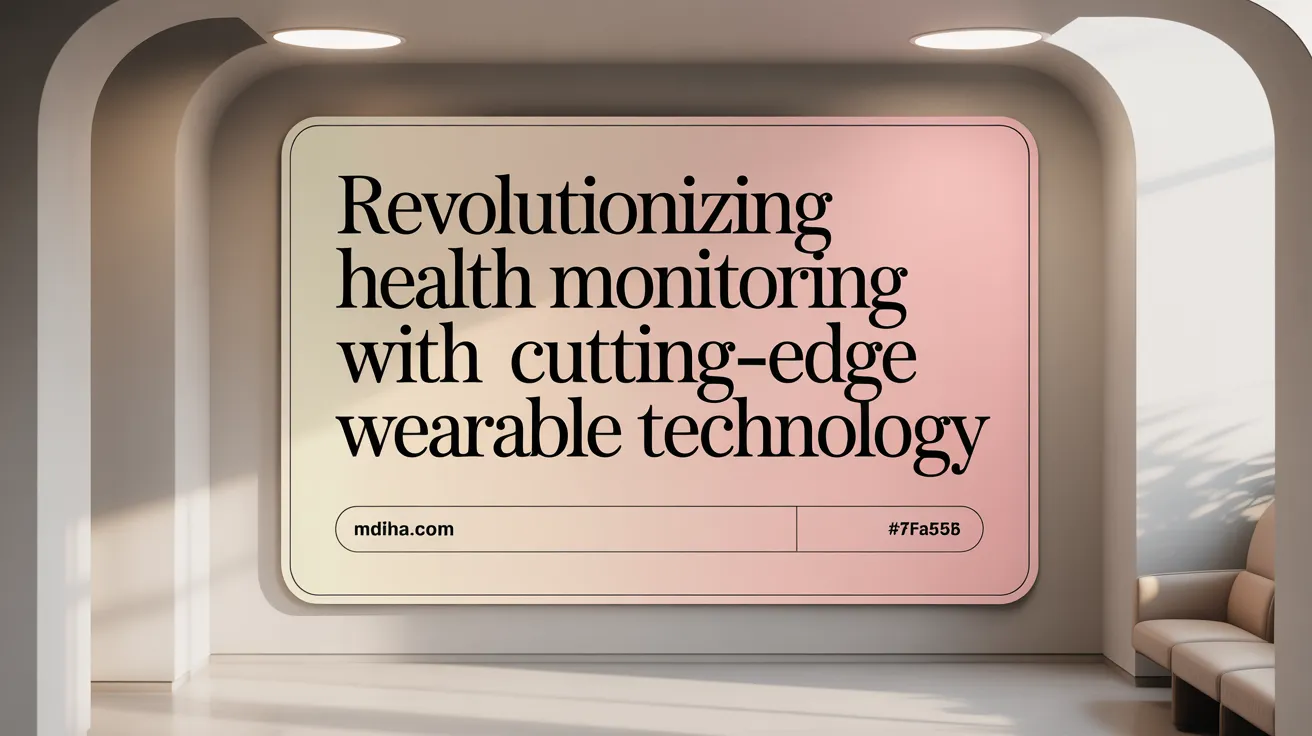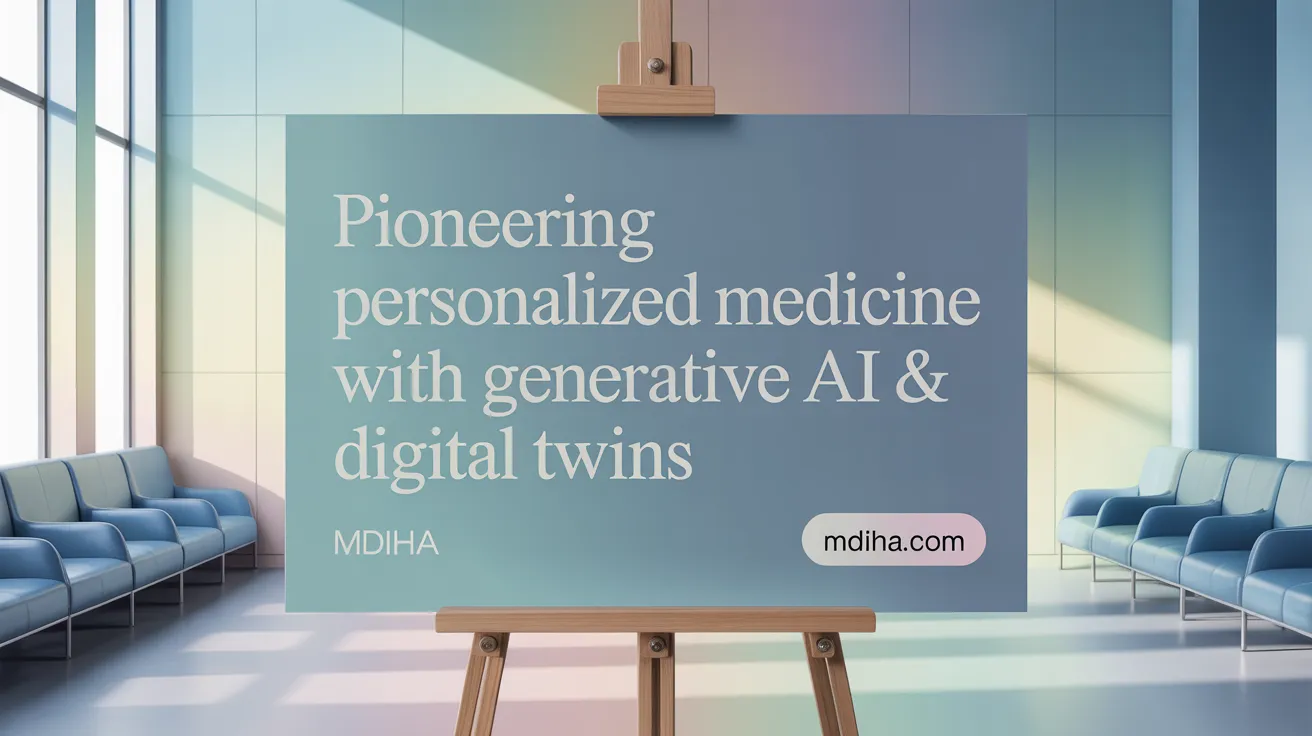Introduction to Personalized Healthcare Evolution
The landscape of healthcare is undergoing a remarkable transformation fueled by technology. From wearable devices that continuously monitor vital signs to sophisticated artificial intelligence (AI) algorithms analyzing complex health data, technology-driven personalized care is becoming a cornerstone in modern medicine. This evolution promises improved diagnosis, tailored treatments, earlier interventions, and enhanced patient engagement—ushering in an era where healthcare becomes more proactive and individualized.
The Emergence of Wearable Technology in Health Monitoring

What Types of Wearable Health Devices Are Common?
Wearable health devices come in many forms, including smartwatches and fitness trackers, ECG monitors, glucose sensors, blood pressure monitors, and biosensors. Popular examples include Apple Watch, Fitbit, Garmin devices, and specialized products like the Omron HeartGuide blood pressure monitor or AliveCor's KardiaMobile ECG device. These devices vary from simple activity trackers to advanced medical monitors capable of real-time vital sign monitoring.
How Do Wearables Support Continuous Health Monitoring?
Wearables track vital signs such as heart rate, blood pressure, oxygen saturation, sleep quality, and glucose levels continuously. This enables early detection of health issues by monitoring subtle changes over time. Continuous data collection allows for proactive management of chronic diseases, arrhythmia detection, and supports patient self-awareness and behavior change.
How Is Data from Wearables Integrated with Healthcare Systems?
Data from wearables can be integrated into electronic health records (EHRs) and healthcare provider systems through the Internet of Medical Things (IoMT). This real-time data sharing facilitates personalized treatment plans and remote patient monitoring. AI-driven analytics enhance the interpretation of wearable-collected data, aiding clinicians in diagnosis and tailoring care remotely.
What Are the Benefits of Wearables for Patients and Providers?
For patients, wearables empower self-monitoring and proactive health management, improving adherence to treatments and lifestyle modifications. Providers benefit from objective, continuous health data enabling early interventions and reducing unnecessary in-person visits. This technology supports personalized care, reduces healthcare costs, and alleviates system burdens, particularly important during healthcare resource constraints.
In summary, wearable technologies are transforming health monitoring by offering real-time, continuous data collection and integration with clinical workflows. This advancement improves personalized healthcare delivery and fosters closer patient-provider collaboration for better health outcomes.
AI and Big Data: Engines of Precision Medicine
AI's Role in Analyzing Health Data
Artificial intelligence (AI) serves as a cornerstone for precision medicine by processing vast and complex health datasets. It excels in understanding, reasoning, and learning from multi-source information to generate insights. These capabilities empower clinicians with augmented intelligence for better decision-making in diagnostics and treatment strategies.
Integration of Genomic, Clinical, and Behavioral Data
Precision medicine leverages the integration of genomic data with clinical histories and behavioral determinants—accounting for roughly 60% of health influences. AI facilitates this by analyzing genetic profiles, electronic health records (EHRs), and socio-environmental factors, resulting in highly personalized care plans. This holistic approach advances early detection and tailored therapies.
Big Data Challenges: Volume, Variety, Veracity
The big data in healthcare is characterized not only by its colossal volume but also by the variety and veracity of data. Diverse data types include sequence genomics, medical images, wearable device outputs, and social determinants. AI-driven analytics address challenges like noise, missing context, and biased datasets by employing advanced algorithms, ensuring reliable results and insights.
Use of AI for Diagnosis and Treatment Planning
AI enhances diagnostic accuracy and treatment optimization through machine learning models that analyze clinical and genomic information. Tools like radiogenomics linking imaging features to gene expression, while predictive models anticipate disease risk and treatment response. AI's ability to synthesize disparate data sources accelerates personalized treatment selection and improves clinical outcomes.
Pharmacogenomics and Genotype-Guided Therapy
AI plays a pivotal role in pharmacogenomics by interpreting complex genetic data to tailor drug dosing and therapy choices. Genotype-guided treatments—in domains such as cancer therapy or warfarin dosing—reflect advances in personalized medicine. AI algorithms refine these therapeutic decisions by predicting drug efficacy and adverse effects, enhancing safety and effectiveness.
Collaborations Driving Innovation: Case Studies from Industry and Academia
Examples of TDK's motion sensors and magneto-cardiometry
TDK is at the forefront of AI and wearable devices in healthcare with its TDK MEMS motion sensors for wearables used in devices for activity classification with wearable sensors, step counting technology, calorie tracking devices, and sleep analysis using wearables. A remarkable innovation from TDK is their magneto-cardiometry for cardiac measurement technology developed through collaboration with Tokyo Medical and Dental University, allowing non-contact cardiac monitoring of cardiac activity without traditional magnetic shielding, enhancing patient comfort and device versatility.
ICsense’s ASIC solutions for healthcare
ICsense, a TDK subsidiary, specializes in custom ASICs for healthcare with Application-Specific Integrated Circuit solutions designed for healthcare applications. Their portfolio includes ASICs for ECG systems, implantable medical devices ASICs, and innovative cancer cell detection chips. These tailored integrated circuits optimize device performance and enable precise health monitoring and diagnostics.
Medical device enhancements via power supply technology
TDK has extended its expertise into power supply solutions for medical devices that elevate the performance and safety of medical devices. These advancements ensure that critical healthcare equipment operates with increased reliability, supporting improving medical device safety and performance and enhanced patient care environments.
Academic partnerships advancing wearable tech capabilities
Academic collaborations play a crucial role in pushing wearable technology forward. TDK's partnership with Tokyo Medical and Dental University exemplifies how joint efforts can lead to breakthroughs like magneto-cardiometry, blending sensor technology with clinical research to produce practical, patient-friendly health monitoring systems.
Overall, these collaborations between industry leaders like TDK and academic institutions are essential in developing the innovative wearable technologies that are revolutionizing health monitoring and personalized care.
Real-World Impact of AI-Powered Wearables on Patient Care
Continuous health monitoring benefits
AI-powered wearable devices facilitate continuous tracking of vital signs such as heart rate, blood pressure, oxygen saturation, and sleep quality. This uninterrupted data collection allows for a holistic view of patient health, enabling clinicians to monitor trends and detect subtle changes that might otherwise go unnoticed during periodic check-ups.
Early detection of diseases and conditions
These wearables assist in the early identification of health issues, including cardiac arrhythmias, diabetes-related glucose fluctuations, and respiratory conditions. Advanced AI algorithms analyze patterns in the collected data to predict exacerbations or critical events hours in advance, supporting timely medical interventions and improving patient outcomes. See more about AI and wearable technology in healthcare and emerging wearable health technologies.
Remote patient monitoring and telehealth support
By transmitting real-time health data, AI-enabled wearables reduce the need for frequent hospital visits. This supports telehealth initiatives, allowing healthcare providers to oversee patients remotely, personalize treatment plans, and intervene proactively when abnormalities arise. Such continuity of care is especially beneficial for chronic disease management and post-operative recovery.
Enhancement of preventive care and treatment adherence
Wearables empower patients by providing personalized insights and reminders that foster healthy behavior changes and medication adherence. The integration of AI personalizes coaching and alerts, helping individuals stick to prescribed regimens, thereby reducing hospital readmissions and improving overall quality of life. Learn more about personalized treatment with wearable data and AI-enhanced continuous health monitoring.
Advanced AI Technologies Enhancing Clinical Decision-Making
Machine learning and deep learning in diagnostics
Machine learning (ML) and deep learning (DL), subsets of artificial intelligence (AI), significantly improve diagnostic accuracy by processing large-scale, complex clinical data. These technologies analyze patient history, genomics, and medical imaging to identify disease markers earlier and more precisely than traditional methods. For example, AI models have demonstrated superior accuracy in detecting cancers, neurological disorders, and cardiovascular diseases compared to human experts (AI in healthcare).
AI tools for imaging analysis and risk prediction
AI-driven imaging tools utilize convolutional neural networks (CNNs) and other advanced algorithms to interpret radiology scans such as MRIs, CTs, and X-rays. These tools enhance risk prediction by linking imaging features with genetic and clinical data, enabling early identification of high-risk patients. AI's ability to detect subtle anomalies supports timely interventions, improving outcomes (AI in Personalized Medicine, AI in healthcare diagnostics).
Automated clinical documentation and administrative assistance
AI-powered medical scribe technologies automate routine documentation tasks, such as note-taking and content summarization during patient visits. This automation reduces clinician workload and administrative burden, freeing more time for direct patient care. Moreover, AI assists in appointment scheduling, claims processing, and coordination among healthcare teams, enhancing operational efficiency (AI in administrative healthcare tasks, Technology creating personalized care).
Use of AI in detecting adverse drug reactions and optimizing therapies
AI analyzes electronic health records and genomic data to predict individual responses to medications, minimizing adverse drug reactions and optimizing dosing regimens. Such pharmacogenomic applications improve treatment safety and efficacy. Additionally, AI supports identification of drug interactions and potential toxicities, facilitating personalized therapy adjustments (AI in pharmacogenomics, AI in personalized medicine).
These AI technologies collectively empower clinicians with timely, data-driven insights, improving diagnostic precision, patient safety, and workflow efficiency (Benefits of AI in healthcare).
Overcoming Barriers: Challenges in Wearable and AI Integration
What are the data privacy and security concerns?
Data privacy and security remain major concerns in integrating AI with wearable healthcare technologies. Wearables collect sensitive personal health information continuously, requiring strong protection protocols to prevent breaches and misuse. Issues of consent, data ownership, and sharing controls must be addressed, especially since data often flows to cloud systems and multiple healthcare entities. Blockchain and federated learning are emerging solutions improving data security and patient privacy in this context (Emerging technologies in healthcare, Integration of wearable technology and AI).
How do accuracy, sensor calibration, and interoperability impact wearable AI?
Accuracy of sensor data from wearables is vital for clinical decision-making, but sensor variability and environmental factors can diminish reliability. Calibration challenges and noise in continuous physiological signals complicate AI analysis. Interoperability issues arise as devices and health systems use different standards, causing fragmented data and limiting utility. Establishing local standards for data quality and better integration protocols is necessary for trustworthy AI-driven healthcare (Wearables for health monitoring, Wearable devices for health).
What are the challenges regarding user engagement and technology accessibility?
User engagement with wearables can decline over time due to technical difficulties, loss of motivation, and privacy concerns. Older adults and underserved populations often face barriers due to cost, design complexity, and lack of digital literacy, potentially exacerbating health inequities. Efforts to improve usability, affordability, and tailored education are critical to broaden adoption and sustained use (Wearables for health monitoring, Wearable devices for health.
How do regulatory frameworks and ethical considerations affect wearable AI deployment?
Regulatory bodies have started developing guidelines and approvals for AI-enabled wearable health devices, but rapid innovation challenges existing frameworks. Ethical considerations include algorithm transparency, bias mitigation, and equitable access to benefits across diverse populations. Human oversight, continuous safety monitoring, and adherence to data protection laws remain necessary to build trust and acceptance (AI and Precision Medicine Conference, Integration of AI in healthcare).
Through coordinated efforts addressing these challenges, wearable AI technologies can realize their potential for personalized, preventive, and efficient healthcare delivery (AI and wearable technology in healthcare, AI-powered wearables in health care).
Future Horizons: Generative AI and Digital Twins in Personalized Medicine

What Are Generative AI Models and How Do They Create Synthetic Patient Data?
Generative AI models such as Generative Adversarial Networks (GANs) and Variational Autoencoders (VAEs) produce synthetic patient data that closely mimics real clinical records. This approach addresses challenges of data scarcity and patient privacy by creating anonymized yet realistic datasets. Synthetic data preserves important disease subgroups and clinical patterns, aiding research without compromising individual identities.
How Does Digital Twin Technology Simulate Individualized Treatments?
Digital twins in healthcare are high-fidelity computational replicas of individual patients, created using AI models that integrate multi-source health data. For example, AI-generated heart models simulate the organ's response to various drugs and conditions, enabling bespoke treatment planning. These models are transparent, adaptable, and able to learn from limited data to cater to rare and complex diseases (Digital twins of human hearts).
What Are the Applications in Complex Disease Modeling and Drug Response Prediction?
Combining generative AI with digital twins allows detailed modeling of intricate disease mechanisms, including cancer progression and cardiopulmonary function. These technologies predict patient-specific drug effectiveness and tolerance, assist in designing personalized therapies, and improve safety by simulating treatment outcomes before actual administration (Generative AI in personalized medicine).
What Is the Potential Impact on Clinical Research and Therapy Optimization?
Generative AI and digital twins accelerate clinical research by generating synthetic cohorts for simulation studies and validating therapeutic strategies. They optimize therapy by enabling precise patient stratification and dynamic adjustment of treatment plans, potentially reducing trial duration and costs. This leads to more efficient, safer, and personalized medical care.
Together, these emerging technologies are poised to revolutionize personalized medicine by offering predictive, adaptive, and privacy-preserving tools that enhance clinical decision-making and patient outcomes.
Empowering Patients: Wearables in Behavior Modification and Self-Management

Wearables Supporting Lifestyle Change and Fitness
Wearable devices such as fitness trackers, smartwatches, and rings offer users convenient tools to monitor physical activity, heart rate, sleep patterns, and calorie consumption. By setting personalized goals and tracking progress, they encourage increased physical activity—studies show users typically add around 1,300 steps per day. Features like reminders, social support, and motivational feedback enhance engagement, fostering sustained behavior change to improve fitness and overall wellness.
Monitoring of Chronic Diseases with Personalized Feedback
For chronic conditions such as diabetes, heart disease, and sleep disorders, wearables provide continuous monitoring of vital signs including blood glucose, blood pressure, heart rhythms, and sleep quality. Devices like continuous glucose monitors, ECG-enabled watches, and ECG monitors deliver real-time feedback, alerting users to potential risks. This enables early intervention and self-management, reducing hospital visits and improving health outcomes.
Integration with Mobile Apps and Health Coaching
Wearables commonly pair with mobile apps that collect and analyze health data, offering personalized coaching and insights. Apps support nutrition tracking, hydration logging, medication reminders, and stress management, helping users make informed health decisions. Advanced apps integrate artificial intelligence to tailor recommendations and encourage adherence, turning raw data into actionable plans that empower patients to take control of their health.
User Challenges and Strategies to Enhance Adherence
Despite benefits, adherence to wearable use declines over time due to concerns about device accuracy, privacy, cost, design, and technological literacy, especially among older adults. Strategies to improve sustained use include provider engagement to encourage adoption, simplifying user experience, addressing privacy concerns, and offering social and motivational support. Research highlights that combining goal setting, progress tracking, and personalized feedback significantly boosts long-term adherence and behavior change. For more on barriers and strategies, see wearable device challenges and adoption.
AI-Assisted Precision Oncology: Transforming Cancer Care
Wearable Device Monitoring in Oncology
Wearable technology enables continuous, noninvasive monitoring of patient vital signs and activity during cancer care. These devices collect real-time data such as heart rate, physical activity levels, and sleep patterns, offering insights into patient wellbeing outside of clinical settings. This continuous monitoring supports early detection of complications and aids in the management of symptoms, allowing clinicians to adjust interventions proactively. For more on this, see Artificial Intelligence in Cancer Care.
AI-Driven Biomarker Identification and Treatment Adherence
Artificial intelligence algorithms analyze wearable data alongside clinical and molecular profiles to identify predictive biomarkers related to treatment response and disease progression. AI can also monitor patient adherence to prescribed therapies by detecting behavioral patterns, improving personalized treatment plans. Combining AI analytics with wearables facilitates tailored oncology care by optimizing treatment schedules and enhancing medication compliance. Learn more about AI in Pharmacogenomics and Personalized Treatment.
Impact on Chemotherapy Tolerance and Frailty Assessment
AI-integrated wearables assess patient frailty and chemotherapy tolerance by analyzing physiological and activity metrics. This helps predict how patients will tolerate specific chemotherapy regimens and adjust dosages accordingly. Frailty assessments aided by continuous data improve risk stratification and personalize treatments, reducing adverse effects and enhancing recovery trajectories. Explore further insights at AI-Driven Wearable Devices for Continuous Patient Monitoring.
Ongoing Challenges and Future Clinical Potential
Despite advancements, challenges such as data privacy, security, standardization of wearable devices, and integration with existing healthcare systems remain. Addressing these issues is crucial for wider adoption. Looking forward, the fusion of AI and wearable technologies holds great promise for revolutionizing oncology care by enabling real-time, personalized interventions, improving treatment efficacy, and enhancing patient quality of life. For a detailed discussion, visit Emerging Wearable Health Technologies Transforming Remote Care.
Technological Synergy: The Role of IoMT, Blockchain, and Robotics
How does the Internet of Medical Things (IoMT) integrate with wearable devices?
The Internet of Medical Things (IoMT) connects wearable devices like smartwatches, fitness trackers, ECG monitors, and biosensors to healthcare networks. This integration enables continuous, real-time health data transmission to providers for proactive management of conditions such as heart disease, diabetes, and sleep disorders. Wearables collect vital signs — including heart rate, blood pressure, and glucose levels — which IoMT platforms aggregate and analyze to support early detection and personalized care plans.
What role does blockchain play in secure patient data management?
Blockchain technology offers a secure, decentralized system for patient data management. It ensures data integrity, confidentiality, and controlled sharing by providing an immutable ledger accessible only by authorized users. This protects sensitive health information from breaches while facilitating interoperability among providers. Blockchain supports transparent data tracking and consent management, fostering trustworthiness in handling electronic health records (EHRs) and wearable device data.
How are robotics advancing surgery and patient care?
Robotic systems are transforming surgical precision with AI-assisted minimally invasive procedures that reduce recovery times and complications. In patient care, robots aid with repetitive tasks and eldercare, enhancing safety and efficiency. AI-powered robotics include surgical assistants and rehabilitation exoskeletons that adapt to patient needs, improving outcomes. These technologies also assist in diagnostics and medication management, contributing to comprehensive clinical workflows.
What is the combined effect of IoMT, blockchain, and robotics on healthcare efficiency and personalization?
The synergy of IoMT, blockchain, and robotics accelerates healthcare delivery and personalization. IoMT provides seamless data flow from wearables, blockchain secures this data and manages access rights, and robotics transform direct patient interventions and operations. Together, they enable continuous monitoring, precise diagnostics, and tailored treatments while reducing human error and workload. This integration fosters a more responsive healthcare system focused on individualized patient outcomes and optimized resource use.
Envisioning Healthcare in 2025 and Beyond

Predicted Growth and Trends in Wearable and AI Healthcare
The wearable healthcare market is expected to soar from $50.3 billion in 2020 to nearly $136 billion by 2025, driven by advancements in sensor technology and AI integration. Smartwatches, rings, and biosensors will evolve far beyond activity tracking, offering continuous vital sign monitoring such as heart rate variability, blood glucose, and sleep patterns. AI algorithms will analyze this vast health data in real time to detect abnormalities early and personalize health recommendations.
Expansion of Telemedicine and Remote Monitoring
Telemedicine will expand significantly, supported by wearable tech and 5G connectivity, enabling seamless remote consultations and chronic disease management. Remote patient monitoring will become standard practice as AI-powered wearables provide clinicians with objective, continuous data, reducing hospital visits and enabling proactive interventions.
Emerging Policies and Ethical Frameworks for AI Use
Governments and regulatory bodies, like the US FDA and the European Commission, are establishing guidelines to ensure safe, ethical AI deployment. These frameworks emphasize data privacy, algorithm transparency, bias mitigation, and human oversight to build trust and equity in AI-driven healthcare as described in AI healthcare regulatory guidelines.
Future Technological Integration Fostering Holistic Personalized Care
The convergence of AI, wearables, genomics, electronic health records, and telehealth will foster a holistic, patient-centered approach. AI will integrate multi-modal data — clinical, genetic, behavioral, and social determinants — to tailor diagnostics and therapies uniquely to individuals. Digital health systems will incorporate caregivers, provide virtual assistants, and facilitate seamless data sharing, improving outcomes and enhancing the patient experience as shown in AI and precision medicine integration.
Conclusion: Toward a Smarter, More Personalized Healthcare Future
The convergence of wearable technology and artificial intelligence is reshaping healthcare into a more personalized, efficient, and proactive discipline. As continuous health monitoring becomes more integrated with advanced AI analytics, patients benefit from earlier diagnosis, tailored treatments, and improved outcomes. Despite challenges in data privacy, device accuracy, and regulatory compliance, ongoing innovation and interdisciplinary collaborations promise to overcome these hurdles. Looking ahead, technologies such as generative AI and digital twins hold transformative potential, enabling highly individualized treatment simulations and accelerating drug discovery. The future of healthcare lies in embracing these technology-driven personalized approaches, fostering empowerment for patients and clinicians alike, and ultimately, improving global health outcomes.
